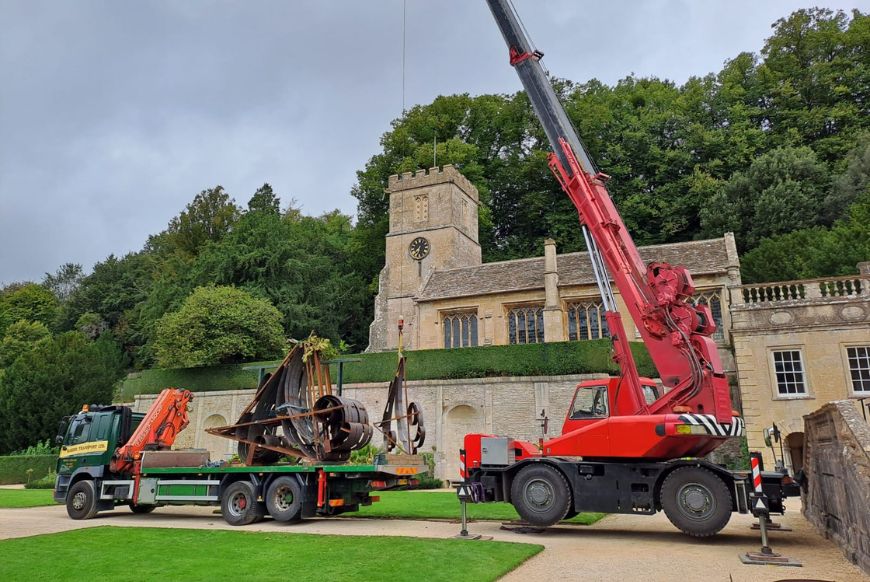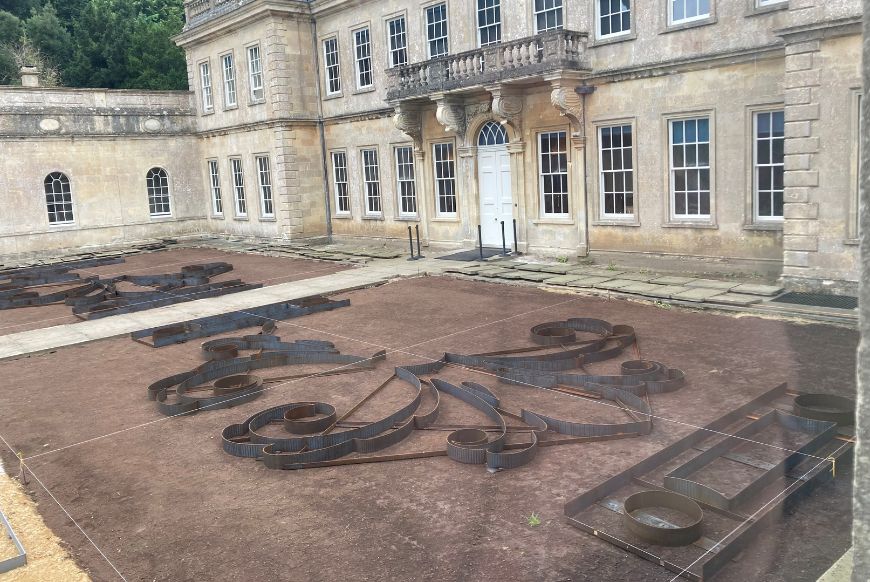The new feature creates a striking welcome as visitors enter the west side of the house and is an attractive link between the house and garden.
In recent years, the area measuring around 10 by 25 metres was plain lawn but, thanks to a generous gift in a will, the garden team has been able to carry out this work. The donation allowed the team to create a design based on historic drawings of the site. Huge steel frames were craned in to make the acanthus leaf shapes that were then filled with carefully cut turf, decorative stones, shells, planting and paving.
Garden and Outdoors Manager for Dyrham Park, Piers Horry said: ‘The recently completed parterre is a real highlight of any trip to Dyrham Park. We’ve used custom made steel frames to make a dazzling 17th-century style entrance to the house. The garden team has loved working on this beautiful parterre and we simply could not have done it without such a generous gift in a will. We’d like to say a massive thank you to the family of the donors for allowing us to create something for thousands of future visitors to enjoy.’
Once the surface was levelled, sections of steel frame, made by local metalworkers and weighing just over four tonnes were carefully craned up the Avenue and into place.
The design uses an attractive swirling acanthus leaf pattern, a plant which represents immortality, rebirth and longevity and which was popular in the 17th century when the house and gardens that still stand at Dyrham today were created by civil servant William Blathwayt.

Once the steel frames were craned in, they were laid into place and then welded together. The frame was first filled with soil, then turf was cut by hand to fit the design, followed by the planting of 850 evergreen Euonymus japonicus hedging plants plus 24 large yew plants shaped into topiary. Hundreds of bedding plants are added for seasonal display, starting with spring tulips and now marigolds (Tagetes white gold max) for the summer. Paving and decoration followed with seashells and a variety of coloured stone such as black calico, used in the 17th century to demonstrate wealth with intricate and detailed decoration. Large plant-filled pots surround the perimeter.
A parterre garden can be seen on an engraving made by Johannes Kip of Dyrham Park dating from 1712. Though the location of the parterre is different, it makes sense to have it where is it next to the house entrance and away from the deer herd. Inspired by the Kip engraving, Dyrham Park gardeners are working on an ongoing project to transform the garden into a vibrant 21st-century garden with echoes of the past. The garden project also draws on modern day examples from sites such as the gardens at Versailles in France, Het Loo in the Netherlands and Hampton Court.

The design for the parterre is based on the ‘parterre de broderie’ style found in English gardens from the early 17th century. This style of parterre contains small hedges filled with colourful flowers and gravel in elaborate fluid patterns reminiscent of embroidery of the period. Garden enthusiasts Stella and Jack Satchell from Bath left money to the National Trust in their will. The couple’s family decided to focus on Dyrham Park after visiting the garden and learning of plans to develop the area to the west of the house.
Mr and Mrs Satchell, who lived in Bath, were lifetime National Trust members and enjoyed well-kept gardens, country walks and tending to their own garden before ill health set in. They were regular visitors to National Trust places in the area. Their daughter Pat Martin said: “Their garden was my parents’ pride and joy and I think they would be thrilled with what’s been achieved at Dyrham. It’s great to think that mum and dad’s support will provide enjoyment for so many.”
Every year, many people decide to leave a gift in their will to help the National Trust’s vital work looking after buildings, garden and land across England, Wales and Northern Ireland. You can find out more about leaving a gift to the National Trust at: www.nationaltrust.org.uk/legacies
Dyrham Park is situated just off junction 18 of the M4 – 8 miles north of Bath and 12 miles east of Bristol. The park is open daily from 10am-5pm (last entry one hour before close).
More information is available at: www.nationaltrust.org.uk/DyrhamPark
Related
Comments
Comments are disabled for this post.













